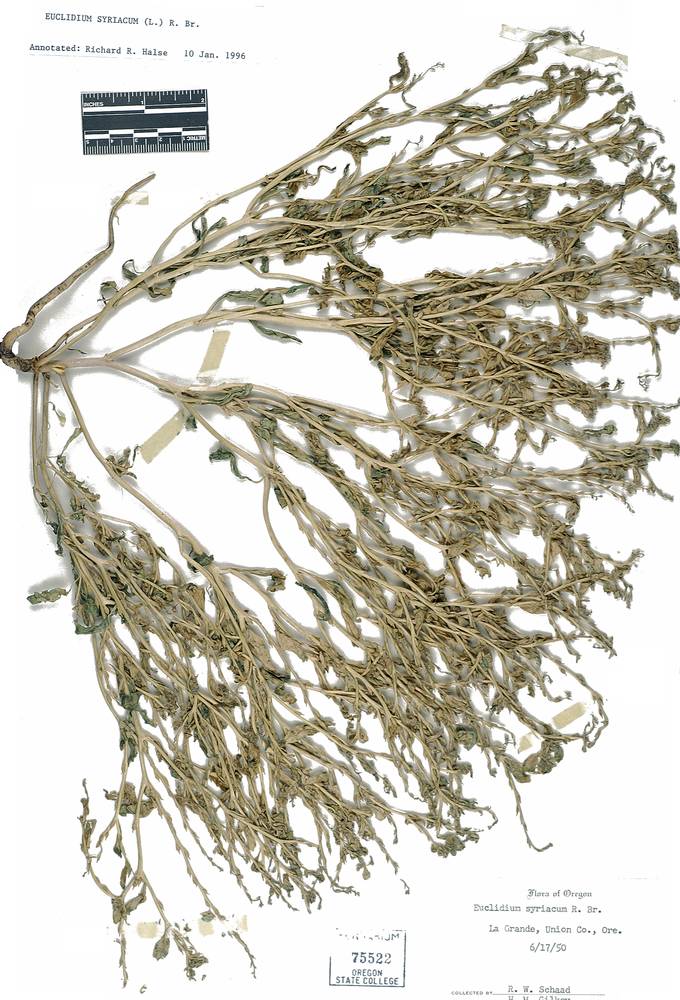
Herbs annual, scabrous pubescent throughout.
Trichomes minutely stalked, 2-forked, mixed with fewer simple and rarely 3-forked.
Stems (4)10–40(45) cm, rigidly branched.
Basal leaves not rosulate, margins entire, dentate, or pinnatifid; petiolate.
Cauline leaves oblong, lanceolate, or elliptic, (1)1.5–7(9) × (0.3)0.7–2(3) cm, bases not auriculate, margins entire, dentate; petioles (0.2)0.5–2(2.5) cm, to sessile or subsessile distally.
Inflorescences bracts 0; fruiting pedicels appressed to rachis, stout, 0.5–1(1.2) mm, nearly half as wide as fruit.
Flowers sepals erect, caducous, ovate to oblong, 0.6–0.9 mm, lateral pair not saccate; petals narrowly spatulate, 0.9–1.3 × 0.1–0.2 mm, slightly > sepals, white, claws slightly differentiated from blades, 0.4–0.6 mm; nectar glands 4, 1 on each side of lateral stamens; stamens 6, slightly tetradynamous, anthers ovate, tips pointed; ovules 2 per ovary, septa complete, thickened, styles persistent, subconical, beak-like, curved, stout, 1–1.8 mm, sparsely pubescent, stigmas capitate, 2-lobed, lobes not decurrent.
Fruits nutlet-like silicles, 2-seeded, indehiscent, erect, appressed to rachis, ovoid, subterete to slightly 4-angled, 2–2.5 × 1.5–2 mm, scabrous, unsegmented; valves woody, veinless; replums strongly expanded laterally.
Seeds aseriate, oblong, 1.3–1.7 × 0.8–1.2 mm, brown, not mucilaginous when wetted; wingless; cotyledons accumbent.
2n=14.
Waste places, roadsides. Flowering May–Jun. 300–1000 m. BW, Col, Owy. CA, ID, NV, WA; northeast to MT, east to NE, southeast to CO, MA; Asia, Europe. Exotic.
as described under Euclidium syriacum
Plants scabrous throughout, trichomes to 1 mm. Stems often ascending, (rigid), usually branched basally and near middle, (0.4-)1-4(-4.5) dm. Basal leaves similar to cauline. Cauline leaves petiolate [(0.2-)0.5-2(-2.5) cm] or (distal) sessile or subsessile; blade oblong, oblong-lanceolate, or elliptic, (1-)1.5-7(-9) cm × (3-)7-20(-30) mm (smaller distally), base cuneate, margins usually entire, dentate, or repand, rarely pinnatifid, apex acute or obtuse. Fruiting pedicels appressed to rachis, 0.5-1(-1.2) mm (ca. 1/2 as wide as fruit). Flowers: sepals 0.6-0.9 × 0.2-0.4 mm, sparsely pubescent; petals 0.9-1.3 × 0.1-0.2 mm, claw 0.4-0.6 mm; filaments 0.5-0.8 mm; anthers 0.1-0.2 mm. Fruits erect, 0.2-0.3 cm × 1.5-2 mm, 2-seeded; replum expanded, to 1.5 mm wide basally, narrowed to apex; style curved away from rachis, subconical, 1-1.8 mm, sparsely pubescent. Seeds 1.3-1.7 × 0.8-1.2 mm. 2n = 14.Flowering May-Jun. Waste places, roadsides, flats; 0-2500 m; introduced; Calif., Colo., Idaho, Mass., Oreg., Utah, Wash., Wyo.; Europe; Asia; introduced also in Australia.Euclidium syriacum is known in the flora area from relatively few collections. The Massachusetts record, Knowlton s.n. (GH), was collected nearly a century ago; it is not known if the species has persisted in that state.